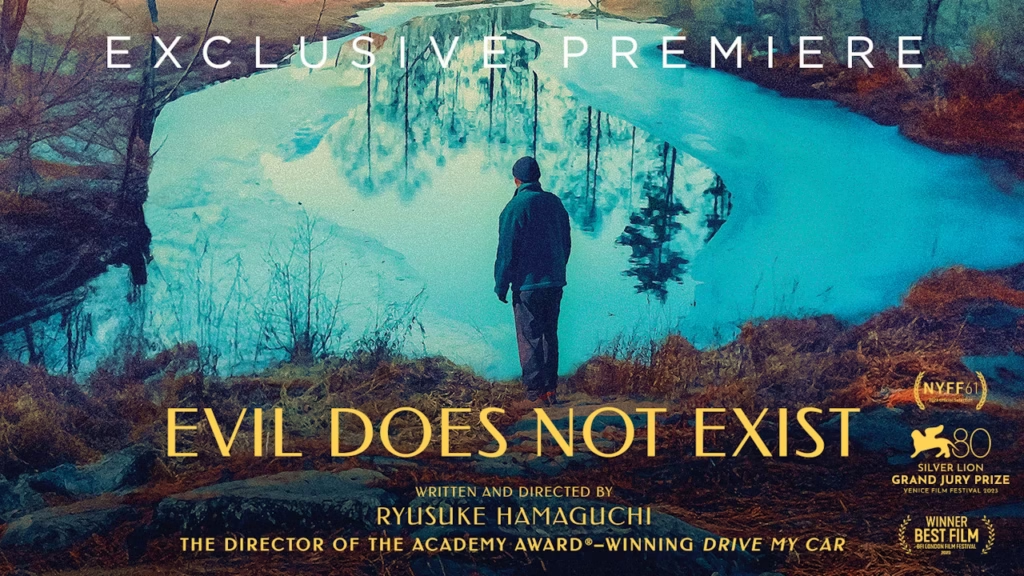
The plot centers around a remote mountainous region of Japan in the quiet village of Harasawa. The villagers form a tight knit community and their way of living reflects deep respect for nature as they are surrounded by lush forests and mountains. A few of the inhabitants of Harasawa are brought to focus, such as the skilled handyman Takumi and his young daughter Hana. Day to day life in Harasawa is quite rough and unrefined, but it has an innovative charm to it. Sounds that can be heard there include the soft flowing of water from the river as well as the sound of udo noodles being prepared at small shops scattered around the village, and wood being cut along with a child curiously running through the woods.
The balance of this village is suddenly upset by two representatives from a Tokyo company who make an unexpected visit. Their goal? Persuade the village inhabitants to allow them to develop a “glamping” facility, which is a new high-end version of camping that caters to the modern tourist. The stark contrast between the urban life and the village life is perhaps best captured in this scene, which in my opinion is the most entertaining part of the entire piece. As part of their cooperative engagement, Harasawa residents articulate their opinions on the glamping investment proposal at a community meeting: their views traverse from a classical mode of eloquence, through impassioned rhetoric, and at times, comic relief. In any case, it does not boil down to just village versus city. As I have already hinted at, these two agents are but the mouthpieces of a greater encompassing force, which allegedly defends the village society.
In general, both the cast and the director have not applied excessive complexity or detailing to their work. But the one major highlight of the film is the soundtrack, created by Eiko Ishibashi, earlier known for her work on the score for “Drive My Car”. It is worth noting that “Evil Does Not Exist” started as a soundtrack idea and only then turned into a feature film. In fact, Hamaguchi was invited by Ishibashi to create images for the music that she intended to write, after which they went on to produce a full length movie. The talented composer provides the visual images of the sequences with an impressive sound backing, dramatic and even disturbing at times which greatly enhances the visual appeal of the scenes.
Hamaguchi could have included several themes and I wouldn’t put it as having a critical eye to them, but at least be able to touch on subjects like eco criticism and eco anxiety, the industrialization of Japan, or even nature’s wombat fierceness. However, and I fathom it is more or less deliberate, he chooses to let it all remain on the outer crust and take it no further. This stylistic-directorial choice, however, would find less disputation were it not for the unclarified contradiction between the final parts of the film and its earlier sections. Indeed, for an hour and a half, the viewer gets used to the pastel moderate-phased performance and decor as well as the semi-documentary nature of Evil Does Not Exist. The last ten minutes of this film, however, do not provide with ample time for the reality of such structural prerequisites to be experienced.
While it is commendable to consciously avoid creating a moralistic film, this optimal ending has now triggered a troubling split between the audience. It is one thing to wonder what Hamaguchi’s purpose was, but expecting the viewers of his film to grapple with “man vs nature”, sounds absurd. Throughout the film, the antagonism between Hamaguchi and the skeptics did seem plausible, but Sudden violence disrupted the film’s elusive outline, and its already intricate nature. Indeed, it is true, as terrifying the sudden violence of the film is, rationality too ceases to exist. Amidst the brutality in the outline of the movie, there lies a spiral layer of violent romance, which remains hidden, and bubbles underneath with great intensity.
My view might seem to be opposite to the general view, but it has crossed my mind that after the massive success of “Drive My Car”, Hamaguchi has to be careful that he does not get locked into a certain type of cinema that would be so difficult to approach and which would be quasi-authorial to the point of being virtually incoherent. I have no doubt that in order to address this Hamlet-like question, we will need to follow his future cinematic endeavors quite closely.
All in all, Hamaguchi has designed a film that pays respect to artsy films, therefore, making its incomprehensible nature its main idea. Sadly, this may not be enough by itself.
For More Movies LIke Evil Does Not Exist (2023) Visit solarmovie







